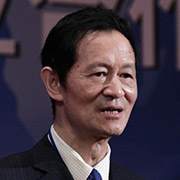The recent successful China-ASEAN Summit gave the China-ASEAN Free Trade Agreement a new impetus. Both agreed to advance the existing FTA to an “upgraded edition”, thus ushering forth a “Diamond Decade” on the basis of a “Golden Decade”. Meanwhile, the Regional Close Economic Partnership (RCEP) among ASEAN 10+6 (China, Japan, South Korea, India, Australia and New Zealand) is also gaining momentum, with its conclusion envisaged by the end of 2015. On the third front, the third round of China-Japan-South Korea (CJK) FTA negotiation is scheduled to be held in Japan from November 26-29.
All these developments have shown China’s energetic moves in the Asian FTA build-up where the US is not a player. Simultaneously, the US-led Trans-Pacific Partnership (TPP) negotiation is also going on with an aim of reaching agreement by the year-end where China is not a player.
Are the two parallel developments competing against each other or are China and the US engaged in a race? The answer is no for three reasons.
First, FTAs and RTAs are common phenomena in the world today. By January 15, 2013, the WTO had been informed of 546 FTAs and RTAs across the world, with 241 in enforcement and another 305 in negotiation or planned. FTAs and RTAs in Asia alone accounted for 257, or half of global total. They tend to cover not only traditional tariff cuts and NTB concessions, but also standards, safeguard measures, service trade clauses, investment, competition policy, labor, environment, government procurement, IPR, etc. By the end of February 2013, the US had enforced 14 FTAs, involving 1+20 countries or regions, covering 46.4% of its exports and 34.7% of its imports. The EU had enforced 35 FTAs, involving 27+56 countries and regions, covering 30.0% of its extra-EU exports and 24.9% of its extra-EU imports. China had enforced 10 FTAs, involving 1+18 countries and regions, covering 29.2% of its exports and 21.4% of its imports. Therefore, FTAs are a common occurrence the world over, with TPP, TTIP, RCEP, CJK and China-ASEAN FTAs being only a few cases among them all.
Second, due to geo-economic laws, a country or a region usually makes FTAs with its neighbors a top priority. The US created the North American Free Trade Agreement (NAFTA) with Canada and Mexico 20 years ago. Combined, Canada and Mexico are still the largest trading partners of the United States. During the first 8 months of 2013, two-way trade between the US and its NAFTA neighbors reached $755.37 billion, or 29.7% of its total trade, even larger than the Asia-Pacific (29.5%), and much larger than the European Union (16.8%). Similarly, the EU has been devoted to European market integration for over 60 years (counting from the European Coal and Steel Community in 1951), as over 55% of EU member countries external trade volume is happening among themselves. Germany, for example, has two-thirds of its total trade within the EU. China’s largest trading partner is East and Southern Asia, which accounted for 40.8% of its total external trade during the first 9 months of 2013, while the US and EU combined account for 25.8%. ASEAN 10, plus Japan and South Korea, account for 24.7%, almost twice that of the US (12.4%). China’s RCEP partners account for 29.7% of its total trade worldwide, exactly the same share as the US NAFTA partners. Also, China has already become the largest trading partner for ASEAN, Japan, South Korea and Australia.
Moreover, the importance of Asia in China’s foreign trade does not show in its size or share only, but also in its close integration of the global supply chain. Among the world’s three leading factories (Europe, Asia and North America), 60% of Asia’s supply chain depends on Asia itself (i.e. among Asian economies), whereas only 9% depends on North America. Logically, China must cement a sound and integrated free market with its Asian neighbors, and make the FTA a priority. Consequently, there is no point to argue that China-ASEAN FTA, CJK or RCEP is directed against TPP or the US. Rather, they are all segments in the global FTA progress. It would be desirable if they could have frequent exchanges and complement one another.
Third, the past decade proved the win-win model and sustainability of the China-ASEAN FTA. From 2002 to 2012, China-ASEAN two-way trade volume increased by 7.3 times, faster than China’s world trade growth. Total China-ASEAN trade hit $400.1 billion in 2012, 10.3% of its world trade, compared to 7.8% 10 years ago. During the first 9 months of 2013, China-ASEAN trade reached $322.4 billion, up 11.6% from a year ago; compared to 7.7% growth in its total world trade, 6.7% growth in China-US trade and -0.8% growth in China-EU trade. Cross-border investments broke the $100 billion barrier by the end of 2012, a net increase of $70 billion during the past 10 years.
A key factor behind this success has been a win-win model where both sides shared the same fate. Since the global financial crisis broke out in 2008, China has proved to be a significant market for goods from ASEAN countries.
From 2008 to 2012, China managed to provide a market for $78.85 billion worth of additional goods to ASEAN, $27.16 billion for Japan and $56.41 billion for South Korea; the US only provided $12.79 billion in additional market value to ASEAN, $7.13 billion for Japan and $10.81 billion for South Korea. China enjoys an apparent advantage in making the FTA partner a winner as well.
Looking ahead, we should also focus on a fundamental problem, which is already evolving – too many FTAs and RTAs are flooding the world, and will lead to an increasingly complicated effect where one agreement overlaps another. Sooner or later there will be a process of synergy, including among RCEP, CJK and the TPP. A forward-looking vision and a fair and equal negotiation process among different FTA players are likely in the future.
He Weiwen is a Standing Member of the Executive Council of the China Society of WTO Studies.





